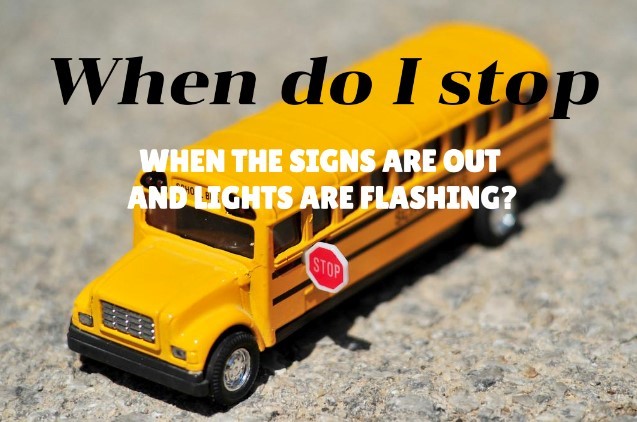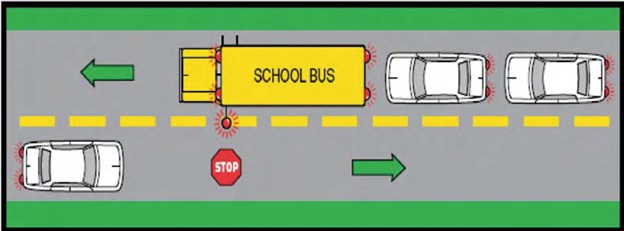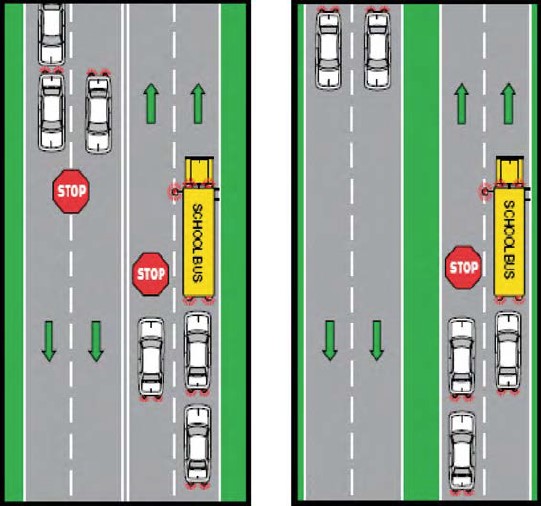
What do you do when a school bus is stopping?

Every day across the country, nearly 500,000 buses carry more than 25 million students to and from school and school-related activities.
School buses are the safest vehicles on the road, and one of the safest modes of transportation overall. In fact, children are much safer traveling in school buses than in any other vehicle, whether they’re going to and from school, a field trip, or a sporting event. They are even safer riding in a school bus than in a car with their parents or caregivers.
Louisiana School-Bus Laws
Motorists must stop at least 30’ from a stopped school bus that is loading or unloading children. All 50 states have a law that makes it illegal to pass a school bus that is loading or unloading children. Always be prepared to stop when lights are flashing. When do you know you have to stop? Bus drivers will activate the flashing yellow lights of the bus at least 100 feet but no more than 500 feet before the school bus stop. As the bus comes to a complete stop, the flashing red lights and stop signs will activate. The motorist must remain stopped until the school bus signs and lights are deactivated, and the bus begins to move. Make sure that you scan the area for children who may still be moving in or near the road before you start to drive again. This is required by law whether you are meeting the bus or traveling behind it. Every state has a law making it illegal to pass a school bus that’s stopped to load or unload passengers with its red lights flashing and stop arm extended. Far too many drivers simply choose to ignore the law for their own convenience and put children at risk. If you are following a bus, increase your following distance in order to get a better view. Anticipate the bus stopping at its pickup and drop off points. Never pass a bus with its red lights flashing on the right or on the left. Buses typically travel at lower rates of speed and make frequent stops. During the school year school buses are most likely to be on the road during a three-hour period in the morning and a three-hour period in the afternoon.

But are there times when you DO NOT have to stop for a school bus that is stopped with its signs out and lights flashing? Yes. You do not have to stop when the bus is stopped in a loading zone completely off the roadway and where pedestrians are not allowed to cross the roadway.
When a school bus is stopped in opposite lanes on a roadway separated by a ditch, grassy median, elevated concrete barrier or any obstacle that prevents traffic from driving thereon, you are not required to stop. Drivers are also not required to stop for a stopped school bus when traveling on four-lane or five-lane roadways which are separated by a dedicated two-way left turn lane. Drivers must stop on a four-lane roadway when it is not separated by a barrier.

School Bus and Automobile Crashes
Bus crashes can be serious. According to the U.S. Department of Energy, an empty car can weigh up to 5,000 pounds, while an empty school bus can weigh up to 14,500 pounds. This disparity may increase if the bus is at full capacity. What does this mean? Colliding with a school bus versus a passenger vehicle could mean you might sustain more serious personal injuries and more extensive damage to your vehicle. You may have to deal with injuries, such as:
Concussions or traumatic brain injuries (TBIs); Back pain; Damage to or loss of extremities; Mental trauma; Whiplash; or Death
Such injuries can result in both economic and non-economic damages. Typical examples of economic damages are wage losses, job loss, medical expenses, and funeral costs. Typical examples of non-economic damages are physical pain and suffering, emotional pain and suffering, loss of enjoyment of life, and disfigurement. In short, economic damages can be quantified. Non-economic damages cannot be quantified; they are subjective and subject to speculation. No ever person is the same, so non-economic damages vary from person to person.
You May Need A Lawyer To Recover Your Damages
Under Louisiana law, an accident victim has one year from the date of injury to file a lawsuit or, if possible, settle the case. When this one-year period expires, the accident victim loses the right to sue the wrongdoer for both economic and non-economic damages.
Most people have no experience with the legal system and dealing with insurance companies. It is important to know that there are two Points of View (POV). The accident victim wants Justice, meaning full compensation. The insurance company wants to pay the injured person as little as possible for damages. So if you need an attorney, you want one who cares about you, who spends time getting to know you, who keeps you informed about your case, who spends the necessary time to explain the law, and who know what evidence is needed to prove all of your damages.
At the Law Offices of Richard R. Kennedy, you will have Richard Kennedy and Richard Kennedy III to represent you. Is this important? You bet? Why? Because you will know who is representing you; you know that we will keep you timely informed about your case and all the information you need for us to do our very best to get justice for you. When you call us, we answer your calls and we promptly answer your emails. The bottom line is simple: we and our clients get to know each other on a personal — not just a professional — level. That is critical in building trust. So, if you need a lawyer, call us at (337) 232-1934 to get started.
